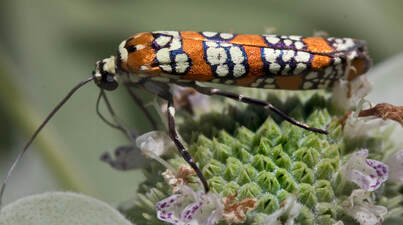 Moth of Heaven If you follow nature news you have probably already heard of the dreaded Spotted Lanternfly and its host plant, the deplorable Tree of Heaven a.k.a Ailanthus Tree. Knowing how awful these invasive trees can be, you will probably be cheered to learn about a pollinator taking advantage of this growing opportunity. Native to South Florida down to Costa Rica, the Ailanthus Webworm Moth, or Atteva aurea, feeds and lives in its natural host plant, the native paradise tree. When the Asian Tree of Heaven was introduced as a good tree for urban landscaping in 1784 (big sigh) the Ailanthus webworm moth found this invasive tree to be just as yummy and useful as its native host tree and has since been found more northward than in the past. While Ailanthus Webworm Moths do die off in our cold winters, they quickly move back once spring hits and are considered a useful pollinator in our gardens! In flight this moth resembles a wasp and when not in flight can look very similar to a beetle or true bug. As adults, they feed on the pollen and nectar of our beautiful blooms. Before striking out to pollinate the world, these little diurnal moths spend almost all of their life-cycles in the loose webs that enclose the leaves of the ailanthus tree, which allows the caterpillars to feed without leaving the safety of the web and stay until adulthood. Janet Douberly loves the Ailanthus Webworm Moths at Downtown Greens. This article was originally published in the May 2023 edition of Front Porch Magazine. Read the full publication by using the link below.
0 Comments
Leave a Reply. |
AuthorWrite something about yourself. No need to be fancy, just an overview. Archives
February 2024
Categories |
 RSS Feed
RSS Feed